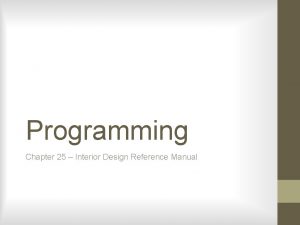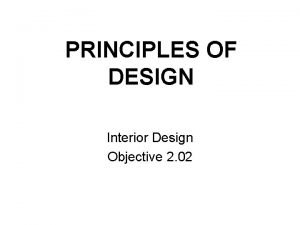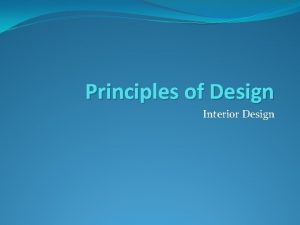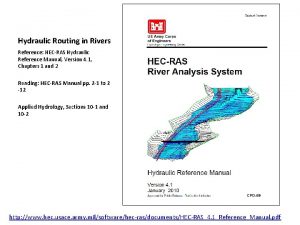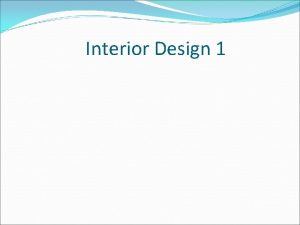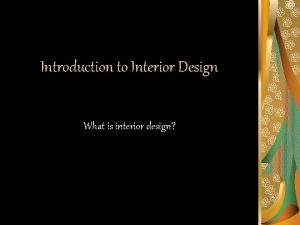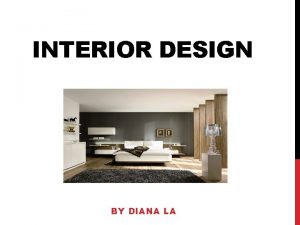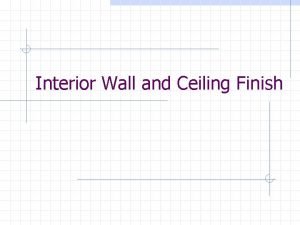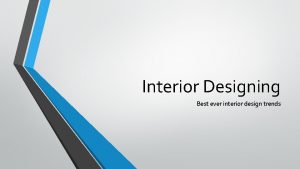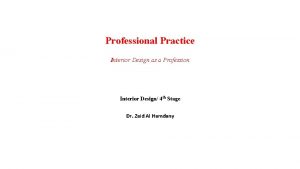Programming Chapter 25 Interior Design Reference Manual Definition










- Slides: 10

Programming Chapter 25 – Interior Design Reference Manual

Definition • Programming is a process during which information about a problem is collected, analyzed, and clearly stated to provide a basis for design. • It defines a problem before a solution is attempted. • Programming is problem analysis whereas design is problem synthesis.

Information Gathering • • • Client's specific needs Analysis of existing building Aesthetic considerations Space needs Adjacency needs Codes review Budget requirements Scheduling requirements Human factors Environmental responsibility Social and cultural influences

Programming process • Small projects may require statement of goals and a list of spaces and furniture/ equipment needs • Large projects will require large bound volumes • Link to more information on programming: http: //www. wbdg. org/design/dd_archprogramming. php

5 -Step process 1) Establish goals: what the client wants to achieve and why. Know the objectives the client is trying to reach with each space. 2) Collect and analyze facts: existing conditions, number of people to accommodate, space adjacencies, user characteristics, existing building parameters, expected growth, budget, etc 3) Uncover and test concepts: develop abstract ideas that are functional solutions to the clients problems without defining the physical means that could be used to solve them. A programmatic concept is a performance requirement related to methods of solving a problem or satisfying a need. Example: provide a medium level of security to protect against theft of merchandise without making the security methods obvious. The Design concept will identify specific physical responses that attempt to achieve a programatic goal. Example: Provide a central cash/ wrap station at the entry/exit point of the store.

5 -Step Process 4) Determine needs: balance desires with available budget. Separate wants from needs. Determine quantity, quality, budget, and time frame. 5) Stating the problem: succinctly state the essence of the problem- the most important aspects of the problem that serves as the basis for design and as criteria by which the solution can be evaluated. Focus on form, function, economy, and time. The problem statement is the bridge between programming and the design process and should be agreed upon by the client and programmer/ designer.

Major Considerations • Form: existing conditions, physical and psychological environment, quality of construction. • Function: how people will use the space, activities to be performed, adjacencies • Economy: initial cost, operating costs, and life-cycle costs • Time: scheduling considerations, and need to expand

Programmatic Concepts Your homework is to identify abstract ideas on how to solve performance problems in the KHH. Areas to work on for next class include: • Prioritizing the spaces to renovate by most needed to least important • Identify the overall character- image to be portrayed • Identify overall goals/objectives • Start working on programming document template. • Identify Activities by space

Program Format • Typed document that is easy to scan. Refer to template. • State the overall goals for the design project. (ie: to increase sales by updating the image of the store) • List individual space and its sq. footages • Identify the function of individual space such as "to improve circulation and personal interaction among departments. • State the problem for the space • List adjacencies • List activities • List furniture and equipment needs. • Other special needs such as lighting, acoustics, flexibility, electrical etc. • Sketch existing conditions

Human factors • The field of human factors involves the correctness of fit between objects and spaces and the needs of people using those objects and spaces • Anthropometrics: the measurement of the size, proportions, and range of motion of the human body. • Ergonomics: the study of the relation between human physiology and the physical environment. It uses the information developed by anthropometrics, but it goes further by studying exactly how humans interact with physical objects such as chairs, control panels, and desks. Adjustability between different users is important. • Human comfort: based on the quality of the environmental factors such as temperature, humidity, air movement, air quality, sound and light.
 Interior design programming
Interior design programming Decorative design patterns
Decorative design patterns Elements and principles of interior design ppt
Elements and principles of interior design ppt Examples of opposition in interior design
Examples of opposition in interior design Opposition in interior design
Opposition in interior design Reference node and non reference node
Reference node and non reference node Reference node and non reference node
Reference node and non reference node Hec ras hydraulic reference manual
Hec ras hydraulic reference manual Kyoto protocol reference manual
Kyoto protocol reference manual Et 500 gate motor programming manual
Et 500 gate motor programming manual Kinco plc manual
Kinco plc manual
